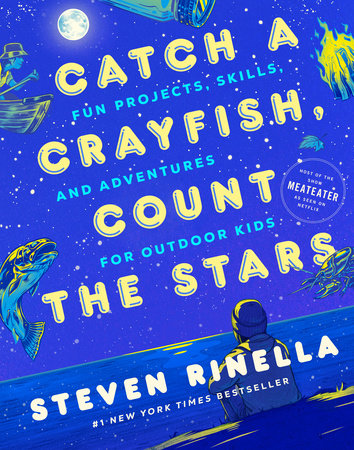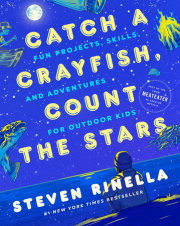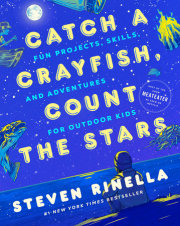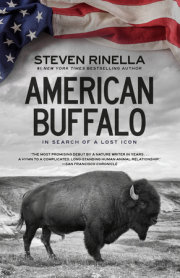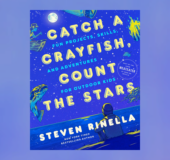I
Navigation and ExplorationEver wondered if you have what it takes to survive in the wilderness? That’s what the projects in the first part of this book are about. You’ll learn how to use the night sky to find your way home, follow the tracks of animals, build shelters out of natural materials, and start a fire that will heat and light your campsite. The more you practice these skills and the others in this section, the more comfortable and capable you’ll become in the outdoors.
Build an Exploration KitEarly American explorers on the Great Plains were amazed to see that Native Americans could make boats big enough to carry an entire family using nothing but a knife and natural materials found along the riverbanks. They could turn the skin of a drowned buffalo into a boat by attaching the hide to a frame of willow limbs secured with cord made from the buffalo’s skin, sinews, and tail. If they needed to hunt for a buffalo, they could make arrow points from special types of stone known as flint, chert, and obsidian. They’d start by banging two stones together in order to chip away a piece that was the right shape and thickness. Then they’d shape and sharpen the piece into an arrowhead by carefully flaking away chips of stone with a sharp deer antler, a process called knapping.
What could you accomplish in the wild, with the right tools and skills? The saw on a multi-tool could help you make a spoon out of a deer bone. A flashlight would let you see down into the burrow of a ground squirrel, so you could learn about how these animals prepare for winter—and maybe “borrow” a little dried grass for an emergency fire-starter. A water bottle is essential for hydration, and it’s also a great place to store wild blueberries. With the right pieces of gear, you can be ready for all kinds of adventures in the great outdoors. Whether you’re going on a big camping trip with your family or just riding your bike to the playground to meet a few friends, it’s a good idea to be prepared for whatever Mother Nature might send your way. That’s why the first project in this book is to build yourself an exploration kit. To keep things organized, pack the kit inside a small stuff sack or a big ziplock bag. Keep the kit in your backpack so it’s ready to grab the next time you head outside. Over time you’ll want to customize your kit, but here are some useful things to get you started.
• Picture of family and parent contact info. Keep a picture of your family with your parent’s contact information written on the back in case of emergency.
• Water bottle. It’s important to stay hydrated, and wide-mouth water bottles also make great containers for edible berries—or for a grasshopper that you might want to carry along with you as a pet for the day.
• Snacks. You’ll need lots of energy for outdoor adventures. Always keep your backpack loaded with extra snacks like trail mix, cheese sticks, dried fruit, and jerky. Some explorers will throw in a couple of pieces of candy, but stay away from anything that will turn into a gooey mess in high temperatures. There’s nothing worse than opening up your pack and finding that everything is all sticky and messed up.
• Extra baggies or container. Carry an empty medicine bottle or a 1-gallon ziplock baggie for gathering any interesting stuff you find along the way. That could be rocks, flowers, seashells, or anything you like.
• Small aquarium net. These are more useful than you might guess. Use them to catch insects or scoop up crayfish and minnows from creeks and ponds.
• Rope. The best kind of all-purpose rope is called 550 paracord. It became popular among soldiers during World War II, when they’d scavenge the cord from old parachutes and use it for boot laces, lanyards, and even belts to hold up their pants. It has a minimum breaking strength of 550 pounds, which means it could support the weight of three grown-ups without breaking, even though it’s only about as thick as two or three spaghetti noodles put together. Twenty feet of cord is more than enough to build a fort or make a stringer that can carry home a batch of fish.
• Flashlight. Pack a small flashlight or headlamp for exploring at night, or in case you get unexpectedly caught out after dark. Rechargeable flashlights are great. For lights powered by disposable batteries, try to get one that uses AA batteries. Those are usually easy to find.
• Field guides. Books like Peterson’s Field Guides for Young Naturalists and the Smithsonian Fossil and Rock Hunter and Bug Hunter will help you identify the plants, animals, rocks, and insects you see outdoors.
• Binoculars. A pair of compact binoculars with 7- or 8-power magnification will let you closely examine birds, animals, and other far-off objects.
• Waterproof notebook and a space pen. Use them to draw pictures of what you see outside, or write notes about your day to your family and friends. You can also write down a list of things that you need to add to your exploration kit. (P.S.: They’re called space pens because they’re what astronauts use in outer space—they work in zero gravity or upside down, they’re waterproof, and they don’t leak ink.)
• Magnifying glass. Useful for getting a close-up view of insects, grains of sand, and other tiny natural wonders. On a sunny day, you can even use one to start a campfire by aiming a beam of light at an old bird’s nest or a pile of dried grass.
• Multi-tool. A small multi-tool will probably become the most important part of your exploration kit. You can pull splinters with the pliers, cut sticks with the saw, take apart equipment with the screwdrivers, and clean fish or dissect big bugs with the knife.
• Rain jacket. The weather can change without warning from warm and sunny to cold and rainy. Always pack a rain jacket or poncho.
• Medical supplies. If you fall and get a scrape or cut, you can patch yourself up and get back to having fun if you keep some basic first-aid supplies like Band-Aids and antiseptic wipes inside a plastic baggie in your backpack.
• Odds and ends. A proper exploration kit should be small enough to carry around all day but should still have everything you need. Depending on where you’re going, what you’re doing, and the time of year, you might want to add a warm hoodie, a hat, an emergency space blanket, whistle, bug spray, sunglasses, sunscreen, trail maps, or even an extra inner tube for your bike tires.
Make a Magnetic CompassWhen compasses were first invented, a couple of thousand years ago, the instruments didn’t immediately replace the stars as the main tool for navigators. But they were helpful to sailors and other travelers at times when it was too cloudy to see the stars at night, or in the daytime when the sun was shining. Eventually they came to be one of the primary means of navigation, used in combination with paper maps.
The way traditional compasses work is pretty cool. We don’t feel it in our bodies, but the earth is actually magnetized, due to the flow of liquid metals in the planet’s outer core. And compasses contain a metal needle or pointer that responds to the earth’s natural magnetic field by pointing toward north. This part gets a bit confusing, but compasses are pointing toward something called the magnetic north pole. Unlike true north, which is based on the permanently fixed location of the North Pole, the magnetic north pole moves around slightly as the earth’s magnetic field shifts. That doesn’t usually affect navigators, since magnetic north is close enough to true north that compasses can be used to navigate in any direction, especially over short distances. (But if you want to learn about something really crazy, you should do some research on how the earth’s magnetic poles will shift from time to time. There have even been periods in the past when your compass’s needle would have pointed to the south!)
Once you know where magnetic north lies, it’s very easy to roughly determine the other three cardinal directions. If you’re facing north, south lies directly behind you, east is directly to your right, and west is directly to your left. Some people like to use the saying “never eat sour worms” to help them remember the order—north, east, south, and west, working clockwise from north.
Whenever you’re outside and in unfamiliar territory, it’s always a good idea to know the cardinal direction of your destination, along with what direction would lead you to safety if you got lost. Start by studying a map of the area before a trip into the outdoors (an adult can help with this step!) and make a note of which direction you’ll be traveling. Use your compass to periodically determine the location of the four cardinal directions while you’re out exploring so that you’re always aware of which direction you’re going and which direction would take you back to your car or to the nearest trail, road, or town.
Copyright © 2023 by Steven Rinella. All rights reserved. No part of this excerpt may be reproduced or reprinted without permission in writing from the publisher.

